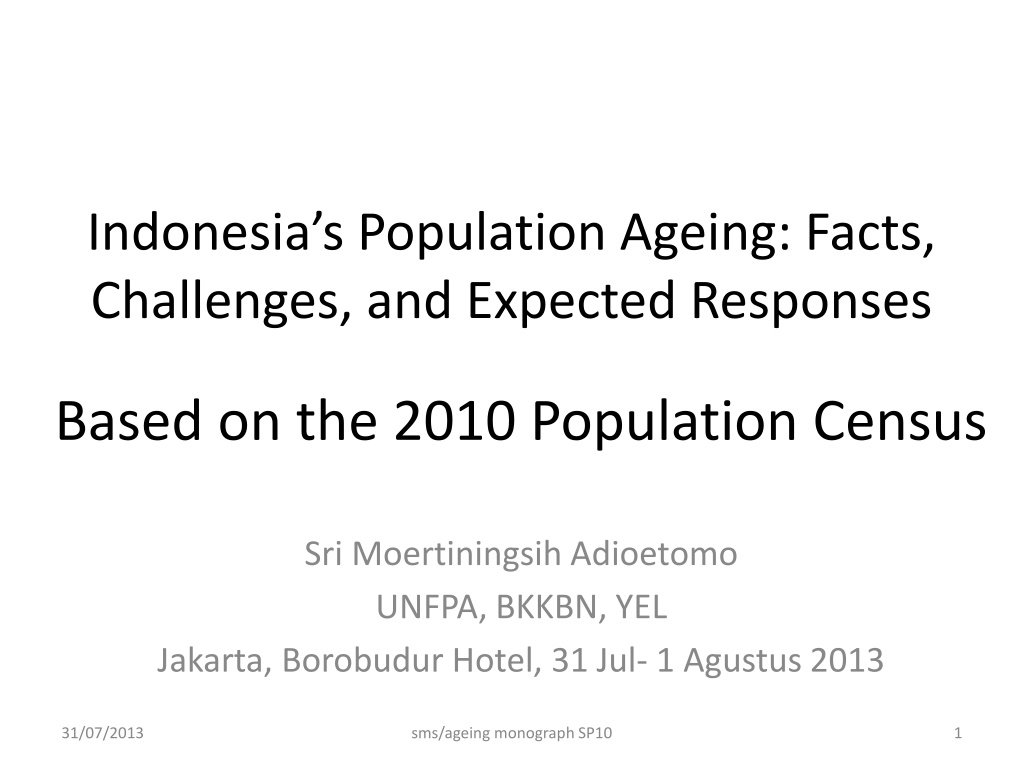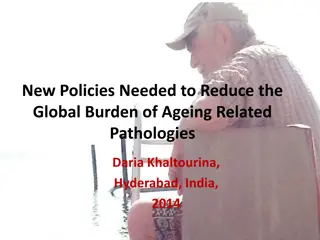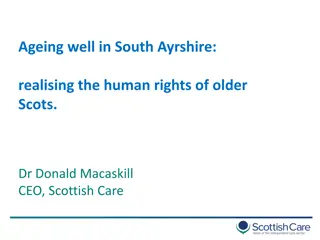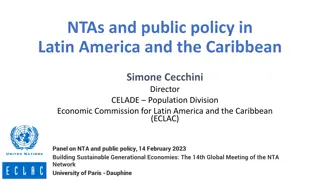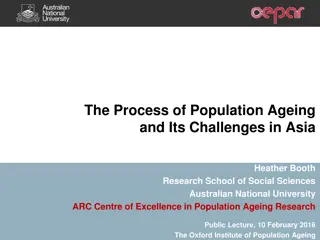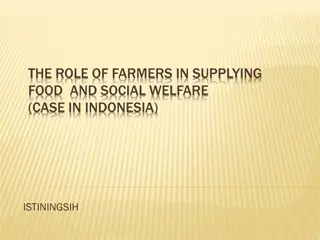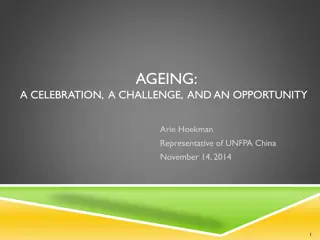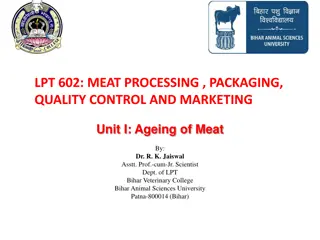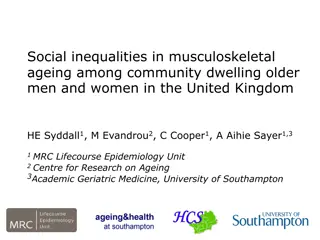Understanding Indonesia's Population Ageing: Trends, Challenges, and Responses
The monograph explores Indonesia's population ageing based on the 2010 Census, highlighting demographic shifts, social and economic consequences, and policy recommendations. It delves into the causes such as demographic transition, mortality decline, fertility trends, and age structural changes. The analysis underscores the importance of addressing the needs of the elderly population for effective policymaking and community development.
Download Presentation

Please find below an Image/Link to download the presentation.
The content on the website is provided AS IS for your information and personal use only. It may not be sold, licensed, or shared on other websites without obtaining consent from the author. Download presentation by click this link. If you encounter any issues during the download, it is possible that the publisher has removed the file from their server.
E N D
Presentation Transcript
Indonesias Population Ageing: Facts, Challenges, and Expected Responses Based on the 2010 Population Census Sri Moertiningsih Adioetomo UNFPA, BKKBN, YEL Jakarta, Borobudur Hotel, 31 Jul- 1 Agustus 2013 31/07/2013 sms/ageing monograph SP10 1
Introduction The 2010 Population Census collected abundant information to provide profiles and characteristics of Indonesia s older persons, disaggregated by age and sex at the national and provincial level. Expounding the demographic, socio-economic characteristics will be very useful in developing policy, government and partners network, elder friendly community; as well as service programs and empowerment of the elderly. many aspects of population ageing in Indonesia. The monograph provides vital information on the profile of Indonesia s older persons, including provincial variation and the need for greater attention to older women. It explores the social and economic consequences of population ageing and recommends policy responses. This Ageing Monograpfh is possible through the assistance from UNFPA 31/07/2013 sms/ageing monograph SP10 2
Presentation Outline Introduction The factor that caused population ageing, Changes in Age Structure, perubahan struktur umur penduduk Indonesia, Current and Future Trends. Indonesia s Ageing Index, Census 2010 Demographic Profile of Older Persons in Indonesia, Census 2010 Provincial Variation of Ageing Population, Census 2010 Conclusion and Recommendations for Policy 31/07/2013 sms/ageing monograph SP10 3
The Causes of Indonesias Population Ageing Factor 31/07/2013 sms/ageing monograph SP10 4
The Causes of Indonesias Population Ageing Factor: Demographic Transition Mortality Decline and Increase in Life Expectancy Fertility Decline Trends in TFR and NRR, Indonesia, 1971-2035 Trend in IMR and Expectancy of Life, Indonesia, 1971-2035 6.00 160 80.00 Avereage number of childern per woman (TFR) and 5.60 145 72.3 71.3 70.7 140 70.00 Infant Deaths per 1,000 birtts 5.00 4.68 120 60.00 59.8 replacement level (NRR) Life Expectancy (years) 4.00 100 50.00 45.7 3.33 80 40.00 3.00 IMR TFR 2.39 71 e0 NRR 2.34 60 30.00 2.282.182.102.021.96 2.041.91 2.00 40 20.00 1.46 1.141.101.101.00 1.00 1.000.90 26 1.00 24 21 20 10.00 0 0.00 0.00 1971 1980 1990 2000 2010 2015 2020 2025 2030 2035 1971 1980 1990 2000 2010 2015 2020 2025 2030 2035 31/07/2013 sms/ageing monograph SP10 5
Age Structural Changes: The effect of Indonesia s demographic transition is age structural changes, 1971,2010,2030 85+ 85+ 85+ 80-84 80-84 80-84 75-79 75-79 75-79 70-74 70-74 70-74 65-69 65-69 65-69 60-64 60-64 60-64 55-59 55-59 55-59 50-54 50-54 50-54 45-49 45-49 45-49 40-44 40-44 40-44 35-39 35-39 35-39 30-34 30-34 30-34 25-29 25-29 25-29 20-24 20-24 20-24 15-19 15-19 15-19 10-14 10-14 10-14 5-9 5-9 5-9 0-4 0-4 0-4 20,00 10,00 0,00 10,00 20,00 20,00 10,00 0,00 10,00 20,00 20,00 10,00 0,00 10,00 20,00 Percentage Percentage Percentage Male Female Male Female Male Female The number of children aged 0-14 years in 1971 reached age 30-45 years in 2010, and it will create the large number of workforce, in 2030 those children will reach age 50+ years and in 2040 will be elderly people. (SMAdioetomo based on Indonesian Population Projection 2010-2035 and pop structure 1971) 07/2013 17/OWN CALCULATION 6
What are the implications? Economic security, health and health care and social supports for elderly people on the present and future. Therefore, it is important to take into account ageing preparedness of young people toward ACTIVE AGEING. The large number of workforce and youth need to be better prepared to become highly qualified human capital, with skills and the competency to challenge the global competitive labour market so that they are ready and prepared when they are aging. AT THE MOMENT, INDONESIA HAS A LARGE ABSOLUTE NUMBERS OF ELDERLY PEOPLE. The 2010 Population Census recorded 18.0 million older persons, or 7.6 per cent of the total population of 237.6 million people. 31/07/2013 sms/ageing monograph SP10 7
The Number and Profile of Older Persons, Census 2010 31/07/2013 sms/ageing monograph SP10 8
Number of Older Persons by Age and Sex Age Male Female Total 60-69 5,152,324 5,600,468 10,752,792 70-79 2,373,803 3,060,433 5,434,236 80+ 763,937 1,092,747 1,856,684 Total Population 60+ 8,290,064 9,753,648 18,043,712 % of total population 6.9% 8.3% 7.6% The number of older persons aged 80+ has reached to almost 2 million people, do they have adequate income? Do they still healthy and do not they suffer any disabilities, loss of hearing, inability climb stairs? With whom do they live, and who accompany or take sms/ageing monograph SP10 personal care of him? 31/07/2013 9
Data from the 2010 indicates that more than half of older persons live in rural, and older women outnumber older men, which is seen across all ages and place of residence Urban Male 2,251,233 966,782 292,256 3,510,271 Male 2,901,091 1,407,021 471,681 4,779,793 Female 2,443,541 1,284,601 449,986 4,178,128 Female 3,156,927 1,775,832 642,761 5,575,520 Total 4,694,774 2,251,383 742,242 7,688,399 Total 6,058,018 3,182,853 1,114,442 10,355,313 60-69 70-79 80+ Total Rural 60-69 70-79 80+ Total 31/07/2013 sms/ageing monograph SP10 10
The higher age, the greater gap between male elderly and female elderly Sex Ratio (Jumlah perempuan lansia per 100 laki-laki lansia) Kota Desa 109 109 133 126 154 136 119 117 Umur Total 109 129 143 118 60-69 70-79 80+ Total lansia 60+ Every 3 female elderly aged 80+ years old, there is two elderly male at the same age. In rural, this comparison is slightly lower. Is this feminization of older persons? Why so? Because women live longer than men? 31/07/2013 sms/ageing monograph SP10 11
Life Expectancy at birth increases from only 45 years in 1970 to 70 years in 2010, and this will gradually increase to 74 years in 2035 80.00 74.3 74.1 73.8 73.3 75.00 72.6 72.2 70.00 67.3 Expectancy of Life (Years) 70.5 70.2 69.9 69.4 68.7 68.3 65.00 61.5 63.5 60.00 Male Female 53.7 58.1 55.00 50.00 47.2 50.6 45.00 44.2 40.00 1990 1971 1980 2010 2015 2000 2020 2025 2030 2035 31/07/2013 sms/ageing monograph SP10 12
How many years their remaining length of life? Older women aged 60-64 years are expected to live for another 18.7 years until they die, while older men at the same age only have 16.7 additional years. Life Expectancy of Indonesia Older People 20.0 18.7 18.0 16.0 14.0 16.7 12.0 Years 11.5 Laki-laki Male Female 10.0 Perempuan 10.3 8.0 6.2 6.0 4.0 5.7 3.0 2.0 1.3 0.0 60-64 65-69 70-74 75-79 80-84 85-89 90-94 95-100 100+ If the retirement age is only 55 to 60 years old, how do they live the rest of their lives? Especially for those who do not have pension at all, should they work for the rest of their lives? 31/07/2013 sms/ageing monograph SP10 13
Indonesias Ageing Index, Census 2010 31/07/2013 sms/ageing monograph SP10 14
Indicator of Population Ageing: Ageing index increases, support ratio declines 1971-2035 The number of older persons per 100 children The number of working age persons per one older person 25.0 80.00 70.00 74.4 20.0 21.3 60.00 Potential Support Ratio Ageing Index 62.1 17.215.8 50.00 15.0 50.1 40.00 13.913.312.510.9 39.4 10.0 30.00 31.4 9.1 20.00 26.3 7.56.4 23.6 5.0 10.213.516.6 10.00 0.00 0.0 1980 1990 1990 1971 2010 2015 1971 1980 2010 2015 2020 2000 2020 2025 2030 2035 2000 2025 2030 2035 There is 26 older persons per 100 children, will become 74 per 100 children in 2035. How do we motivate children to care about elderly people? Bagaimana memotivasi anak agar peduli lansia? In 2010 there were only 13 workers who supported the older persons, and in 2035 there will be only 6 workers per 1 older person. The declining proportion of workers is accompanied by the increasing number of older persons who need social assistance. In other words, there will be less and less tax payers, while at the same time there are also increasing trend of older persons who need tax financed social assistance. 31/07/2013 sms/ageing monograph SP10 15
Socio and Economic Characteristics of Indonesia s Population Ageing, Census 2010 31/07/2013 sms/ageing monograph SP10 16
Data from the 2010 Population Census reveals that in general, education of Indonesian older persons is low. However, there is a sign that education of the future older persons will be better(cohort effect). Percentage of older persons by education and age, Census 2010 46.9 50.0 45.0 39.0 38.4 40.0 30.9 35.0 25.4 21.9 30.0 20.4 25.8 25.0 20.0 15.0 8.2 16.8 7.2 10.0 4.7 4.2 3.4 60-69 70-79 80+ 1.5 5.0 2.2 2.6 0.5 0.0 No education High School Primary School University level Not finish primary Junior Secondary school 31/07/2013 sms/ageing monograph SP10 17
It is seen that being a woman and living in rural areas means that they are less likely able to read and write Latin characters and speak Bahasa Indonesia especially those aged 70 years old. Percentage of older persons who read and write Latin characters by age Male Female Rural Urban Total Age 60-69 70-79 80+ 81.9 69.0 58.5 63.2 46.2 36.5 63.6 47.2 37.7 83.2 68.9 57.3 72.1 56.2 45.6 Percentage of older persons who are capable of speaking Bahasa Indonesia Male Female Rural Urban Total 60-69 70-79 80+ 83.8 72.3 63.0 69.2 54.9 46.5 67.8 52.9 44.4 87.2 75.9 66.7 76.2 62.5 53.3 It is important to use simple messages in local language to deliver information on programmes and services targeted to these people, particularly for rural women 31/07/2013 sms/ageing monograph SP10 18
Marriage: Indonesian older women are less likely to remarry Percentage of Older Population by Marital Status and Sex 84.1 90.0 80.0 70.0 56.5 60.0 50.0 39.1 Males Females 40.0 30.0 13.6 20.0 3.2 10.0 1.5 1.2 0.8 0.0 Single Married Divorced Widowed 56.5 per cent of older women are widowed. With whom do they live? Who do bear their da-to-day life? Are they healthy? Almost all older men are married, who do take personal care of him? 31/07/2013 sms/ageing monograph SP10 19
The higher the age, the more likely older women are widowed: with whom do they live? Male Female 90.0 100.0 83.0 89.1 90.0 80.0 79.1 68.7 80.0 70.0 66.2 70.0 60.0 60.0 50.5 50.0 44.6 50.0 40.0 40.0 31.8 27.4 30.0 30.0 18.7 20.0 20.0 13.6 8.5 10.0 10.0 1.5 1.5 1.5 0.9 0.7 0.6 3.5 2.8 2.4 1.4 1.0 0.9 0.0 0.0 Single 60 - 69 Married Divorced Widowed 70 - 70 Single Married Divorced Widowed 70 - 70 80 + 60 - 69 80 + 31/07/2013 sms/ageing monograph SP10 20
With whom do older persons live? Is there anyone accompanying as potential care givers? 50.0 43.7 45.0 39.7 40.0 33.7 35.0 30.0 23.7 21.8 25.0 18.8 18.2 18.1 16.1 20.0 14.0 13.9 12.6 11.5 15.0 7.7 6.6 10.0 5.0 0.0 Alone Couple Family Three Generation Under One Roof Other 60 - 69 70 - 79 80 + Three generations under one roof is living in the same household, do older persons as the head of household or as grand mother/father who live with their children in law (as the head of household) and their grandson. The older is less likely to live alone. 31/07/2013 sms/ageing monograph SP10 21
In general, older men live with their spouse, family or three generations under one roof. Males 60.0 50.0 37.8 34.8 40.0 33.8 28.3 29.3 30.0 27.7 21.8 19.2 16.6 20.0 13.2 10.4 7.5 11.0 5.4 10.0 3.1 0.0 Alone Couple Family Three Generation Under One Roof 80 + Other 60 - 69 70 - 70 Older persons who live with spouse only (couple) should also been given priority of attention, since the spouses of older persons are usually also older, both may need assistance. How about if both of them are people with disabilities? 31/07/2013 sms/ageing monograph SP10 22
One of five older women aged 70+ years live alone. Choice or Condition? Females 60.0 47.8 50.0 44.2 40.0 37.8 25.5 30.0 21.8 18.2 20.8 18.4 16.0 20.0 13.6 10.3 11.9 10.0 5.5 4.0 4.4 0.0 Alone Couple Family Three Generation Under One Roof 80 + Other 60 - 69 70 - 70 Older women live alone? Childless, neglected or abandoned by the family? Who live with their children and grandson, so does it mean that there is somebody caring him? 31/07/2013 sms/ageing monograph SP10 23
Older workers 31/07/2013 sms/ageing monograph SP10 24
More than half of older person are still working or looking for work, and it is quite worrisome that that 22.6 per cent of the oldest-old (80+ years) are still working or looking for work (37.2percent for men and 12.3 per cent for women Labour Force Participation Rate of Older Persons by Age Groups and Sex, 2010 100.0 79.4 80.0 69.9 61.4 60.0 51.2 60.0 Male Female Total 44.8 40.9 37.2 35.3 40.0 26.1 22.5 12.3 20.0 0.0 60 - 69 70 - 70 80 + All It is good that older persons aged 60-69 years old are still working. However, people aged 70+ years are also still working. Is it a choice or coercion due to inadequate income and insufficient savings? With a minimal amount of pensions, which is not enough to cover their daily expenses, these pensioners have to struggle to maintain their quality of life? What kind of job do they work? Is the job worth it? 31/07/2013 sms/ageing monograph SP10 25
Older persons are not absorbed in the formal sector. They create their own employment. Even older women work as unpaid workers. Percentage Older Persons who Work by Status of Employment and Sex, 2010 Census 45 38.8 40 31.8 30.1 35 30.8 30 25 16.2 20 12.9 13.1 15 9.4 5.7 10 4.5 4.09 2.07 Male Female 5 0 temporary assisted by paid Unpaid family Employee Self employed Self employed Casual worker assisted by permanent employees Employer unpaid worker Is it indicating the lack in social protection? Will Social Security Administering Body (BPJS) capable to cover them? 31/07/2013 sms/ageing monograph SP10 26
Generally older workers work in agriculture, and older women are more likely to work in service sector. Older Person who Work by Indusrty, 2010 80.0 71.7 69.5 65.8 70.0 60.0 50.0 Agriculture Manufacture Services 40.0 28.1 30.0 23.7 21.1 20.0 7.2 6.8 6.1 10.0 0.0 Male Female Total Work in agriculture usually requires physical activity that is not suitable for older persons. Service sector is milder than agriculture., what kind of work is suitable for older women and men? 31/07/2013 sms/ageing monograph SP10 27
Health and Health care of Indonesia s Older People, Census 2010 From the 2010 Population Census information on health of older persons can only be derived from questions on functional difficulties, which are adopted from the Washington Group on Disability Statistics. 31/07/2013 sms/ageing monograph SP10 28
Disability Increases With Age, the older the persons the higher the incidence of disability and Women have higher prevalence of disability. Disability rates by age and sex, 2010 Population Census 70 60 50 40 Male Female 30 20 10 0 0 - 1 2 - 4 5 - 9 90+ 10-14 15-19 25-29 30-34 35-39 40-44 45-49 50-54 55-59 60-64 65-69 70-74 75-79 80-84 85-89 20-24 The 2010 census results on the prevalence of disability, however, are significantly lower than in other countries using functionally based questions and international standard. However, the result of 2010 Population Census clearly illustrates disability patters of older persons according to age group categories. 31/07/2013 sms/ageing monograph SP10 29
Having difficulties in seeing even if wearing glasses, women suffer more than older men do. Severe difficulties Some difficulties 40 40.0 35 35.0 30 30.0 25 25.0 20 20.0 Vision Male Vision Male 15 15.0 Vision Female Vision Female 10 10.0 5 5.0 0 0.0 Loss in sight can be cured through cataracts. Availability of affordable surgery will help them continue working and to facilitate better communication with others. 08/05/2013 SMAdioetomo/SEACmeeting 30
Having difficulties in hearing even if using a hearing aid, women suffer more than older men do. Some difficulties Severe difficulties 40 40.0 Hearing Male 35 Hearing Female 35.0 Hearing Male 30 30.0 25 Hearing Female 25.0 20 20.0 15 15.0 10 10.0 5 5.0 0 0.0 60-6465-6970-7475-7980-8485-89 90+ Loss of hearing can be recovered by wearing hearing aids . Providing affordable hearing aids will help them continue working and to facilitate better communication with others 08/05/2013 SMAdioetomo/SEACmeeting 31
Having difficulties in walking and climbing stairs, women suffer more than older men do. Some difficulties Severe difficulties 40.0 40 35.0 35 30.0 30 Waliking and Climbing stiars Male 25.0 25 Waliking and Climbing stiars Male 20.0 20 Waliking and Climbing stiars Female 15 15.0 Waliking and Climbing stiars Female 10 10.0 5 5.0 0 0.0 60-6465-6970-7475-7980-8485-89 90+ 60-6465-6970-7475-7980-8485-89 90+ Difficulties in walking and climbing stairs are mostly due to arthritis, osteoarthritis and degenerative processes of other body functions. Instead of surgery, which is costly to common people, rehabilitation services are required for these kinds of difficulties. However, there is a question on the availability of medical rehabilitation professionals, especially in rural areas. 08/05/2013 SMAdioetomo/SEACmeeting 32
Having difficulties in remembering, concentrating or communicating with others, women suffer more than older men do. Some diffulties Severe difficulties 40 40.0 35 35.0 30 30.0 Communica tion Male 25 25.0 Communicati on Male 20 20.0 15 Communica tion Female Communicati on Female 15.0 10 10.0 5 5.0 0 0.0 60-6465-6970-7475-7980-8485-89 90+ Dementia or Alzheimer s disease? There should somebody accompany, take care of their daily needs, and assist them in self-care. 08/05/2013 SMAdioetomo/SEACmeeting 33
Having difficulties in self-care, women suffer more than older men do. Some difficulties Severe difficulties 40.0 40 35.0 35 Self Care Male 30.0 30 Self Care Male 25.0 25 Self Care Female 20.0 20 Self Care Female 15.0 15 10.0 10 5.0 5 0.0 0 60-6465-6970-7475-7980-8485-89 90+ Older women are more likely to suffer severe difficulties in self-care. Long-term services will be highly needed by those who are bedridden. Therefore, it is important to focus on the availability of long-term care and rehabilitation professionals in the near future. The total of them reached 5 to 10 percent? 08/05/2013 SMAdioetomo/SEACmeeting 34
Provincial Variation of Ageing Population, Census 2010 This evidence supports the issue that fertility decline is the major determinant of population ageing, beside the increasing longevity. 31/07/2013 sms/ageing monograph SP10 35
Variasi Penuaan dan Fertililitas (TFR) menurut provinsi % Older persons to number of population and TFR by Province of Indonesia TFR % older persons 14 4 12.95 3.81 12 3.56 3.5 10 3 3.01 8 6 2.5 4 1.94 2 1.93 2 0 1.5 Papua West Sulawesi NAD Bengkulu Jambi Lampung Central Java West Kalimantan East Kalimantan South Sumatera DKI Jakarta Bali West Nusatenggara West Sumatera East Nusatenggara Riau West Java East Java Banten Kepulauan Riau North Sulawesi Gorontalo Maluku Central Sulawesi South Sulawesi Yogyakarta Bangka Belitung South Kalimantan Southeast Sulawesi North Sumatera Central Kalimantan North Maluku West Papua Indonesia % Older Persons TFR The determinant factor of population ageing is TFR decline. Different provinces may need different policy responses. Variations on demographic profile among provinces is highly useful to provide evidence for local policymakers, especially in appropriate resource allocation when planning development programmes for the children and human capital development and maintaining the welfare of older people. 31/07/2013 sms/ageing monograph SP10 36
Yogyakarta has the highest ageing index, accompanied with provinces which have the low TFR. The lowest Ageing index is Papua, and West Papua. Population Ageing Index: number of older persons per 100 children < 15 years old based on province 70 59 60 50 38 40 30 20 17 20 6 10 0 31/07/2013 sms/ageing monograph SP10 37
Compared to developed countries, the percentage of Indonesian older persons to total population is still lower than 10 per cent which is when a population can be called an old population. However, in absolute number, it is already very large, that is 18.04 million older persons. Policymakers cannot neglect this unprecedented situation. Number of older person based on province (x1000) 4500 3894 4000 3348 3500 3031 3000 2500 2000 1500 766 670 1000 448 500 0 Yogyakarta has the highest percentage of population ageing (12.95 per cent), but the absolute number of older persons is 447,860 people. This is compared to West Java with only 7.04 per cent are older persons, but there are 3.03 million older people. Therefore intervention to maintain quality of life of older persons should a concern for both measures. 31/07/2013 sms/ageing monograph SP10 38
A Compendium: Data Summary on Elderly People Based on Census 2010 Indonesia is moving toward population ageing Data from the 2010 Census indicates that more than half of older persons, especially, older women aged 70 or older and live in rural areas Older women outnumber older men with 9.7 million women compared to 8.3 million men. Older women are illiterate and unable to speak Bahasa Indonesia, is needed to to use simple messages in local language to deliver information on programmes and services targeted to these people. Any interventions for improving economic security for older persons should take into account older women, poor older persons, and those who live alone or with their spouse and in rural areas. 31/07/2013 sms/ageing monograph SP10 39
Cont (ii) Many of older persons are still working. A choice or coercion? older women are still working as unpaid family workers (although the percentages are declining with the increasing age). Although women live longer, they are not necessarily healthier than older men Indonesian older women prefer to stay widowed rather than remarry and live alone, and older women suffer disability more than older men. Regional variations on ageing index depends on the different levels of stages in fertility decline The impact of family planning programme. May need different policy responses. 31/07/2013 sms/ageing monograph SP10 40
Terimakasih toening@indo.net.id smatoening@yahoo.com 31/07/2013 sms/ageing monograph SP10 41
